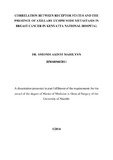| dc.contributor.author | Omondi, Marilynn A | |
| dc.date.accessioned | 2016-11-22T08:31:00Z | |
| dc.date.available | 2016-11-22T08:31:00Z | |
| dc.date.issued | 2016 | |
| dc.identifier.uri | http://hdl.handle.net/11295/97684 | |
| dc.description.abstract | Background: Breast cancer is the second most common malignancy in Kenyan women.
Breast cancer survival is linked to early detection, timely and appropriate treatment.
Furthermore, survival is dependent on stage and biological behaviour of the tumour.
Expression of hormonal receptors by breast cancer cells is one of the key factors in the
management of this disease because of its impact on metastatic spread, recurrence, disease
free survival and overall survival. It however remains unclear how different molecular
subtypes of breast cancer impact on axillary node involvement.
Objective: This study seeks to determine the correlation between expression of hormonal
receptors, Human epidermal growth factor receptor-2 and Ki-67 protein in breast cancer with
that of axillary lymph node status in breast carcinoma.
Methodology: This was a prospective cross sectional study carried out over 9 months at
Kenyatta National Hospital (KNH) surgical wards and histopathology laboratory. Using a
consecutive sampling method, patients with a histological diagnosis of breast cancer and
scheduled to undergo a modified radical mastectomy (MRM) were recruited. Data collected
included age at diagnosis, parity, menopausal status, clinical examination findings, stage of
the disease clinically and pathologically and hormonal receptor status. Data was managed
using MS Excel and analyzed using SPSS version 21.0. Continuous data is presented as
means and categorical variables as proportions. All statistical tests were conducted at 5%
level of significance. The data is presented in form of tables, bar charts and pie charts.
Results: The results of this study show that the most common molecular subtype of breast
cancer in Kenyan women who present at the Kenyatta National Hospital for treatment is
Luminal A followed by TNBC. Luminal A disease was spread almost evenly across all age
groups while TNBC disease was most commonly diagnosed in younger premenopausal
women. In this study most patients presented with T3 disease with a higher number of them
being Luminal A followed by TNBC disease which were prevalent across all T size stages.
Luminal A disease has the highest number of lymph node positive disease tumours but TNBC
and HER-2 enriched disease have a higher propensity for nodal involvement in breast cancer.
However, our study shows no correlation between hormonal receptor positivity or negativity
and expression of HER-2 or lack of it, and nodal status in invasive breast cancer. | en_US |
| dc.language.iso | en | en_US |
| dc.publisher | University Of Nairobi | en_US |
| dc.rights | Attribution-NonCommercial-NoDerivs 3.0 United States | * |
| dc.rights.uri | http://creativecommons.org/licenses/by-nc-nd/3.0/us/ | * |
| dc.subject | Lymph Node Metastasis In Breast Cancer | en_US |
| dc.title | Correlation Between Receptor Status And The Presence Of Axillary Lymph Node Metastasis In Breast Cancer In Kenyatta National Hospital | en_US |
| dc.type | Thesis | en_US |
| dc.description.department | a
Department of Psychiatry, University of Nairobi, ; bDepartment of Mental Health, School of Medicine,
Moi University, Eldoret, Kenya | |



